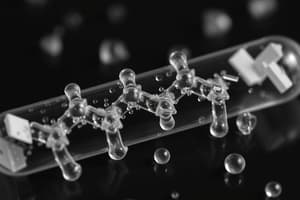Podcast
Questions and Answers
What is atropine's primary origin?
What is atropine's primary origin?
- Animal-derived
- Plant-derived (correct)
- Mineral-derived
- Synthetic
What is the primary pharmacokinetic route of atropine excretion?
What is the primary pharmacokinetic route of atropine excretion?
urine
Atropine has systemic parasympatholytic actions.
Atropine has systemic parasympatholytic actions.
True (A)
Atropine is used as an antidote for __________ poisoning.
Atropine is used as an antidote for __________ poisoning.
Flashcards are hidden until you start studying
Study Notes
Atropine
Pharmacokinetics
- Well absorbed orally, mucously, and parenterally
- Distributed throughout the body (intra and extracellularly) and passes the blood-brain barrier
- Partially metabolized in the liver (70%)
- Excreted in urine partially unchanged (30%)
- Acidification of urine increases its urinary excretion (70%)
Pharmacodynamics
Local Actions
- Eye:
- 1% eye drops: onset 60 minutes, duration 7-10 days
- Paralysis of ciliary muscles (cycloplegia) and ciliary muscle paralysis (passive mydriasis)
- Narrow angle of filtration and loss of light reflex
- Decreased lacrimation
- Skin and mucous membranes:
- Local anodyne (analgesic) action
Systemic Parasympatholytic Actions
- Blocks all types of muscarinic receptors (M1-M5)
- Eye:
- Single oral or parenteral dose: no mydriasis
- Doubled dose: mydriasis for 6-8 hours
- CVS:
- Heart:
- Tachycardia due to vagal tone predominance
- No effect on maximal heart rate due to exercise
- Initial bradycardia may occur due to initial stimulation of CIC in CNS or initial block of presynaptic M1-receptors
- Blood vessels:
- Small therapeutic dose: minimal effect
- Large dose especially in children: atropine flush of face and chest
- Blood pressure:
- Small therapeutic dose: minimal effect
- Reverses hypotension of ACh and Carbachol (M+N)
- Abolishes hypotension of Bethanichol (M only)
- Heart:
- Respiratory tract:
- Bronchodilation
- Dry bronchial secretions and decreased mucociliary clearance
- GIT:
- Decreased salivary secretion (xerostomia)
- Decreased gastric HCl (Pirenzepine and Telenzepine are more selective M1-blockers)
- Relaxation of wall (antispasmodic)
- Constipation due to spasm of sphincters
- Urinary bladder:
- Relaxation of ureter and detrusor muscle
- Retention of urine
- Spasm of sphincters and trigone
- Skin:
- Decreased sweat (anhidrosis)
- Dry, red, and hot skin
CNS Actions
- Mainly CNS stimulant:
- Restlessness
- Excitation
- Hallucination
- Mania (central anticholinergic syndrome, toxic psychosis)
- Medulla:
- Analeptic
- CIC (explains initial bradycardia)
- Anti-emetic
- Basal ganglia:
- Anti-parkinsonian (Benztropine is more selective)
Therapeutic Uses of Atropine
- Antidote for parasympathomimetic poisoning (e.g., Organophosphorus)
- Mydriatic in iridocyclitis, uveitis, and corneal ulcer
- Vagotonia and vasovagal attacks (carotid sinus syndrome)
- Heart block due to β-blockers, digitalis, and myocardial infarction
- Bronchial asthma (Ipratropium and Tiotropium)
- Peptic ulcer (Pirenzepine and Telenzepine)
- Colic (e.g., intestinal, biliary, and renal)
- Diarrhea
- Nocturnal enuresis and urinary incontinence (Emepronium and Oxybutynin)
- Hyperhidrosis
- Preanesthetic medication (Hyoscine)
- Vomiting and motion sickness (Hyoscine)
- Parkinsonism (Benztropine)
Adverse Effects and Toxicity of Atropine
- Manifestations:
- Toxic psychosis
- Parasympatholytic manifestations:
- Mydriasis
- Photophobia
- Blurring of vision
- Glaucoma
- Dry, red, and hot skin
- Dry mouth
- Tachycardia
- Distension
- Constipation
- Retention of urine
- Allergy
Management of Atropine Poisoning
- Physostigmine (I.M. or I.V.) to correct peripheral and central manifestations
- If psychosis: Diazepam
- If hyperthermia: Ice bags and cold baths
- If oral poisoning: Stomach wash
- If respiratory failure: Artificial respiration
Contraindications of Atropine
- Fever
- Glaucoma
- Bronchial asthma
- Tachycardia
- Constipation and paralytic ileus
- Enlarged prostate (Benign Prostatic Hyperplasia)
- After neostigmine in curare poisoning
- Allergy to Atropine
Studying That Suits You
Use AI to generate personalized quizzes and flashcards to suit your learning preferences.




